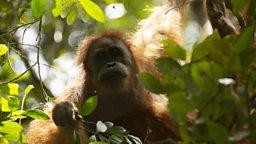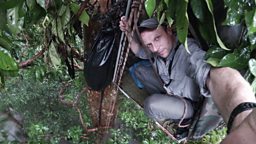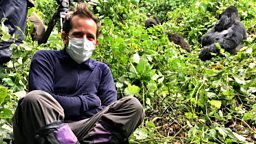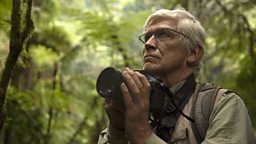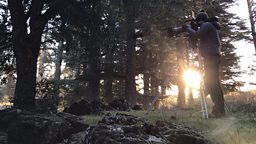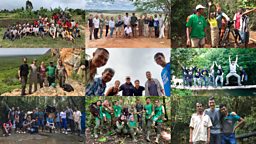Two wild highlands: worlds apart
Wildlife cameraman Lindsay McCrae spent weeks on location for Primates on two different assignments, both in wild highlands, but that’s where the similarities ended...
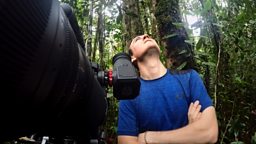
We were the first film crew to attempt to document the Tapanuli orangutan’s behaviour since they had been recognised as a new species in 2017. And it’s no wonder…! Just reaching our camp - a small collection of wooden huts next to a clear stream - required a 6 hour hike to altitude in the Sumatran jungle. Temperatures were around the mid 30s, the ground was very uneven, and at times incredibly steep, and dense foliage completely obscured our view of the sky. We were deep in the wilderness, but it felt strangely claustrophobic.
we began by walking miles of narrow tracks; stopping, listening and staring upwards trying to spot any sign of movementLindsay McCrae
In contrast, in Morocco the group of macaques we wanted to film spent their lives in magnificent, open cedar forests. But here, in winter, the temperatures overnight dropped well below freezing. Our mission was to try and capture the groups’ huddling behaviour, the means by which they keep warm high in the trees where they spend each night.
As expected, both shoots were a real challenge. For the couple of weeks prior to our visit to Sumatra, the scientists following the orangutans hadn’t seen a single individual. So we began by walking miles of narrow tracks; stopping, listening and staring upwards trying to spot any sign of movement. It was immediately obvious; it was going to be a very tough few weeks.
Not only was finding an orangutan difficult, but the conditions we were working in wasn’t something I was used to. Ducking under fallen trees with almost 20kg of camera kit on my back, crossing deep, muddy streams and dodging torrential rain showers every afternoon was a real test. And that’s not to mention looking after electrical equipment in humidity that rarely dropped below 96%.

By contrast, in Morocco we managed to find our group of macaques on the first day. It looked beautiful and, as filming conditions go, it was very comfortable too! But the 20 plus degrees Celsius and cloudless skies was not what we were after. We really wanted to show snow and illustrate the extreme conditions that these adaptable monkeys must endure. Each night temperatures dropped well below zero but, with clear starry skies, there was no snowfall. And so we quickly developed an unhealthy obsession with the weather forecast.
we quickly developed an unhealthy obsession with the weather forecastLindsay McCrae
After 4 long and nervous days searching in Sumatra we finally came across a female orangutan and her young daughter high in the canopy feeding and filming finally began. But the challenge was far from over. Getting even a single shot of such a rare creature, at home high in the canopy, felt impossible.
Having dodged torrential jungle rain showers and negotiated difficult terrain, it would then take time to balance the heavy tripod on the unstable ground (at times, up to a couple of metres of fallen leaf litter!) and then line the camera up to try and get a view through the trees. And most often, I’d find that I was looking through the viewfinder at nothing more than dense foliage. Filming through several stories of canopy layers was preventing me from getting any usable shots. Nine times out of ten the orangutans would have moved, even just slightly, before I was ready and force me to reset again and again… and again.
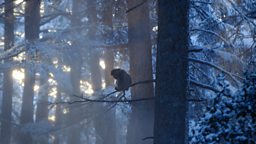
It took 2 weeks in Morocco for temperatures to finally drop. But whilst snow was repeatedly forecast, it failed to materialise. But at least following our group of 50 or so macaques was a lot easier than the orangutans! The cedar forest was spacious and full of enormous, ancient trees. If it wasn’t for the primates dashing around, I could have been in a British forest in early spring. Blackbirds and robins would sing throughout the day, and we even saw the odd red fox dash by. But just as we were running out of time, heavy snow did finally begin to fall late one afternoon, and we filmed as much as we could. And the following morning the clouds had cleared, and the forest was carpeted in thick snow.
Getting even a single shot of such a rare creature, at home high in the canopy, felt impossible.Lindsay McCrae
As the sun rose, long golden rays beamed horizontally through the forest. In the treetops, our huddling macaques were waking up. As they stirred, they knocked the snow off the branches which filtered the light, producing twinkling streaks of light. The falling powder coated the waking macaques on the lower branches like icing sugar. It was a truly mesmerising scene, that was worth the wait. By lunchtime the snow had melted and t-shirt weather had resumed. But we’d got what we’d come for.
In Sumatra, we persevered. The only way to ensure we didn’t lose our our mother and juvenile subjects was to follow them from their nest at dawn till they rebuilt a new nest at dusk, and then trudge back to camp in near darkness. But we were rewarded with some of the first intimate images of one of the rarest primates on the planet. And across the month we were lucky to have fleeting glimpses of 6 orangutans. With a global population thought to be around just 800, we’d seen nearly 1% of all the Tapanuli orangutans in existence. A very sobering thought.
The two shoots couldn’t have been more different; both in terms of our subject and the environment in which each of our Primate subjects lived. The social differences between the two were stark, with the macaques relying on each other, especially in the winter, for survival. Whereas the orangutans spend the majority of their lives avoiding one another! But the bond between the mother and infant is as strong as any in this animal family. And for me, both trips were unforgettable experiences.
